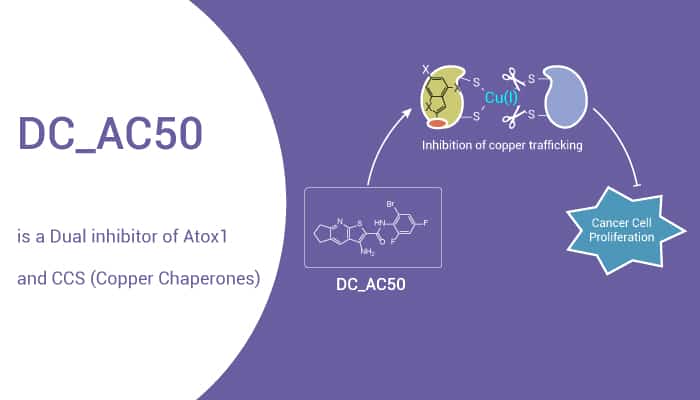Copper is a redox-active transition metal critical for most living organisms. At the same time, it serves as a catalytic cofactor for enzymes. Those enzymes play roles in antioxidant defense, iron homeostasis, cellular respiration, and a variety of biochemical processes.
However, intracellular free copper may exhibit toxic side effects. The uncontrolled accumulation of copper may lead to increased oxidative stress and inappropriate binding to macromolecules.
the copper enters the cytoplasm and it binds to cytosolic copper chaperones such as CCS and Atox1. Atox1 binds Cu(I) with a conserved CXXC motif. At the same time, it delivers copper to the N-terminal metal-binding domains of ATP7A and ATP7B in the secretory pathway.
In this article, we will introduce a dual inhibitor of Atox1 and CCS (copper chaperones), DC_AC50.

DC_AC50 exhibits IC50 values of 9.88 μM, 12.57 μM, 5.96 μM and 6.68 μM in Canine Abrams, Canine D1, human HOS, and human MG63) cells, respectively. Additionally, DC_AC50-treated cells are significantly less mitotically active. It demonstrates a decreased expression of phospho-histone H3 and cell cycle analysis.
At 3 μM, DC_AC50 inhibits the migration and of canine and human OSA cells. Besides, DC_AC50 is highly efficient at inhibiting cancer cell proliferation, including H1299, K562, MDA-MB-231, and neck cancer 212LN cells. However, DC_AC50 fails to exhibit any notable inhibition of the cell proliferation of human normal epithelial lung BEAS-2B cells or breast MCF-10A cells.
In cancer cells, knockdown of Atox1 and CCS may lead to the decreased activity of COX.
As a result, This may show that Atox1 and CCS may contribute to copper trafficking across mitochondrial membranes in cancer cells. The DC_AC50-based inhibition reduces cell proliferation as potently as cisplatin and more effectively than the copper chelator TM.
In conclusion, Inhibiting intracellular copper chaperones is a method for reducing/preventing acquired chemotherapy resistance. DC_AC50 is a potent dual inhibitor of Atox1 and CCS (copper chaperones) for cancer research.
Reference:
[1]. Jordon M Inkol, et al. Vet Comp Oncol. 2020 Dec;18(4):559-569.
[2]. Jing Wang, et al. Nat Chem. 2015 Dec;7(12):968-79.